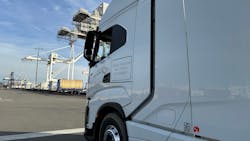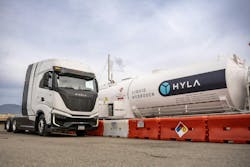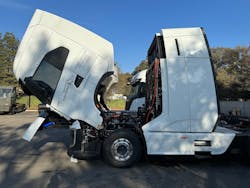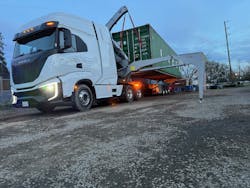Drayage driver's first impressions of Nikola Tre FCEV
In 2023, the California Air Resources Board (CARB) passed the Advanced Clean Fleets Regulation (ACF) Drayage Truck Requirements, which will eliminate fossil-fuel trucks from the drayage sector by 2035. New rules that went into effect on Jan. 1 of this year also prevent any truck with a pre-2010 engine from being used for transport activities at ports and railyards, and only zero-emission drayage trucks can now register in the Truck Regulation Upload, Compliance, and Reporting System (TRUCRS) database.
In preparation, Bill Hall, the founder and managing member of California drayage fleet Coyote Container, ordered five Nikola Tre FCEVs (fuel cell electric vehicles), the first of which he received in December on his birthday. He had been interested in fuel cell trucks since seeing a prototype of the Nikola Two, a sleek sleeper-style truck at the 2019 Advanced Clean Transportation Expo.
Nikola officially started production on the FCEV over the summer—after several years of development and many ups and downs. Later in the year it became the first OEM to market with a hydrogen-powered commercial truck. Last year, 42 Tre FCEVs, which use Bosch fuel cells, were made at Nikola’s Coolidge, Arizona plant, and Hall now had one of them.
And he couldn’t be happier with his decision, based on a recent run he himself drove from the Port of Oakland to Port of Long Beach.
“If there was any one truck that I would want to be in all the time, it's that fuel cell truck,” Hall affirmed.
A note on hydrogen fueling
Before getting into Hall's trip, let's address most glaring issue for FCEVs: the lack of hydrogen fueling stations. They require fewer stops to refuel than EVs do to recharge, but building up hydrogen infrastructure will take a herculean effort between public and private interests.
For FCEVs to scale, the cost of processing hydrogen will have to drop. The Inflation Reduction Act did include a clean hydrogen production credit, but there's still a long way to go. And in California, the only state with any substantial hydrogen infrastructure, things appear to be going backwards. Shell Hydrogen just closed down its seven light-duty passenger stations, citing "hydrogen supply complications and other external market factors," according to a letter sent to customers from Andrew Beard, VP of Shell Hydrogen.
That said, providing fueling stations has always been a part of Nikola’s plans. A division called Nikola Energy does offer mobile fueling solutions through its HYLA brand, so any customer can get started of fuel cell pilots even without permanent fueling stations.
On that note, on Feb. 5, 2024, Nikola Energy did open its first modular refueling station in Ontario, California. The new station can fuel up to 40 Tre FCEVs per day, and this is only the beginning. The company expects to establish up to 60 hydrogen refueling stations, with nine of these planned by the end of Q2 2024.
“Easing the transition to a zero-emission trucking future and prioritizing access to a hydrogen solution network is our top objective and we’re just getting started,” said Ole Hoefelmann, president of Nikola Energy. “Once the nine planned solutions are in place by mid-2024, Nikola will have established one of the world’s largest heavy-duty hydrogen refueling networks, providing customers accessibility at their current locations and along their planned routes.”
Charging even a few heavy-duty electric trucks draws about a 1 MW from the grid, so scaling to 40 per day would be not easy feat, either. Given that passenger cars will increase in volume, and also draw more energy from the state's spotty grid, California may need hydrogen to pick up some of the energy burden.
This only works if FCEVs are reliable, and in Hall's case, he found the technology is getting there, though not without its issues.
But why? Fuel cells are more complicated and expensive than battery-electric powertrains, but also allow a truck equipped with the zero-emission technology to travel a much greater range—and in heavy-duty trucking, how far a truck can go without stopping is everything.
Another more mature zero-emission vehicle option, the battery-electric truck, has a longer track record, more models available, and is well-suited for drayage’s short hauls to and from ports. The downside is battery-electric trucks require a lot of power—and no small amount of time—to recharge. Even with the Volvo VNR Electric's extended range battery, 250 miles of range would be difficult to achieve, especially as the power dwindles during long port dwell times, especally on a hot day when the driver has the A/C running. They need to stop and recharge far more often than a diesel trucks, which get over 1,000 miles per tank. Stopping to plug in and the fill the battery means less productivity for the truck per day.
Coyote started in 2021 with a handful of diesel trucks, and each need to be productive for the business to turn a profit. Fueling up at the hydrogen pump takes around 20 minutes, around the same amount of time a diesel truck spends at the fuel island.
But how is the range? The Tre FCEV purportedly has a 500-mile range, and Hall’s truck performed even better than advertised during the January 2024 trip down the West Coast
“I went 400 miles and I had 140 to 142 miles of range left when I got to Pier C, which was plenty of room for me to go the 50 miles up to the mobile fueler,” Hall explained.
First impressions from the driver
Hall noted the Tre displayed its advantages from Hall’s very first stop at the Port of Oakland, starting with the vehicle’s cabover design, which offers a tighter turning radius.
“If you're in a tight spot and you want to spin your truck and trailer around, that's the truck that will do it,” Hall noted. “It’s amazing because the wheelbase allows you to do that turning with the front wheels all the way at the front of the cab.”
Additionally, Hall told Fleet Maintenance that he appreciated the Tre FCEV’s overall power and quiet functionality, another feature that particularly benefits drayage drivers.
“For us guys who do drayage, we come up to a podium at the gates and you always have to shut off your engine so the clerk can hear you, but with [the hydrogen fuel cell truck], you don't have to do that,” he explained.
This would be true of BEVs as well.
Read more: Nikola commercial launch proves hydrogen trucks no longer a joke
Any trip starts with a pre-trip inspection, and drivers will need to perform these differently than they're used to with diesel trucks. Instead of checking the engine oil level, a driver looks at cooling tank levels, along with power steering fluid. The cooling tanks are accessible by splitting the cab, Hall explained, which he accessed by opening the grille, tilting the radiator forward with a strap and release. He said he then removed a small grille member, and using a remote control, opened the center section of the truck. This allows drivers to check both cooling tank levels and suspension systems.
Hall added that he appreciated the smooth ride the Tre FCEV provides, as well as the vehicle’s overall power, comfort, and visibility.
Because battery management is important factor is getting an optimal range, Hall did have to be more attentive when climbing hills.
“They have a little selector switch to prepare [the truck] for uphill, standard, or downhill, so you tell the truck what terrain you're going to be operating in,” the former marine engineer explained.
This impacted the Tre FCEV’s energy management, especially when approaching the formidable ascent through the Tejon Pass. To maximize battery efficiency, Nikola advised Hall to start preparing the battery before he hit the pass. So, Hall switched his vehicle to the "hill climb" setting around Grapevine, California, charging the battery for an hour before he began his ascent.
“I did that and it charged the battery up to the 80% range,” Hall recalled. “And by the time I got to the top, it was down in the 30% range because it was using that extra power from the battery to help augment the fuel cell.”
But once he reached the top of the pass, he was able to switch the Tre FCEV into the Downhill Mode to charge the battery. But none of these differences impacted the Tre’s power, Hall noted in a LinkedIn post, as he was able to take the steep climbs during his journey at the same pace he would have in a diesel truck.
“On the downhill portion after cresting Tejon Pass, I flipped the vehicle into Downhill Mode and during that time I would say the battery was maintaining itself in the 40-48% state of charge," the owner-operator explained. "As I approached flatter terrain I switched to Standard Mode and the battery state of charge began to rise near 60%. I then switched to Uphill Mode in anticipation of a climb back up to Ontario and the Nikola mobile fueler after leaving Pier C in Long Beach."
This was beneficial to Hall due to a small glitch he encountered when he reached the Port of Long Beach pier. A safety valves on one of the five hydrogen tanks got stuck. The system shut off the fuel cell as a safety precaution. The frugal battery managment beforehand left Hall with about 20 miles of range left (at reduced power), and he was still able to drop off his container.
After exiting the terminal, Hall met Nikola’s Mobile Service Tech Team outside the terminal gates, where they were able to retrieve the the truck and troubleshoot the issue. Nikola replaced the tank and returned the vehicle the next week.
“I am very impressed with the Nikola warranty service response,” Hall said later.
The first of any trucking technology will face similar issues, as the length of operation and extreme conditions push designs to their limits. Fifteen years ago it happened with diesel trucks' emissions systems, which still are a leading cause of downtime, and it continues with BEVs.
Time will tell if fuel cell trucks will help fleets improve uptime, or cause more headaches than they are worth. For now, Hall considers the inaugural port-to-port run a success, and the way the OEM reacted when a problem arose.
“Nikola’s all about a fast response, and when we’re first adopters, we know that things are going to come up that we need to deal with," Hall said. "I’m prepared for that.”
Hall is excited to continue pushing hydrogen transportation’s development. He next plans to take the Tre FCEV to Reno, Nevada and back and observe how it handles the long climb from Central Valley to Donner Pass.
“This is a journey,” Hall concluded. “In six months to a year from now, it’s going to be interesting to look back and see where we started and where we're at in that point in time.”
About the Author

Alex Keenan
Alex Keenan is an Associate Editor for Fleet Maintenance magazine. She has written on a variety of topics for the past several years and recently joined the transportation industry, reviewing content covering technician challenges and breaking industry news. She holds a bachelor's degree in English from Colorado State University in Fort Collins, Colorado.



